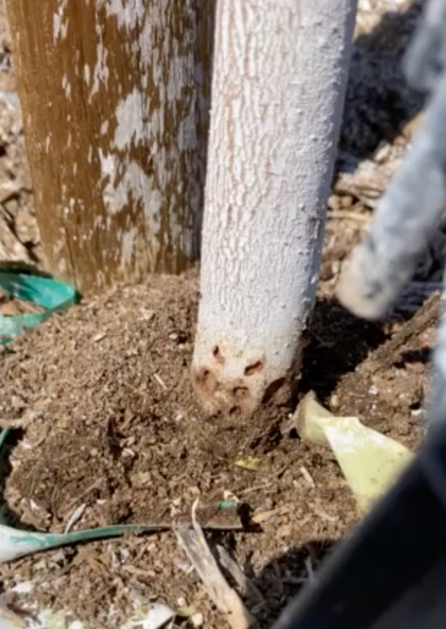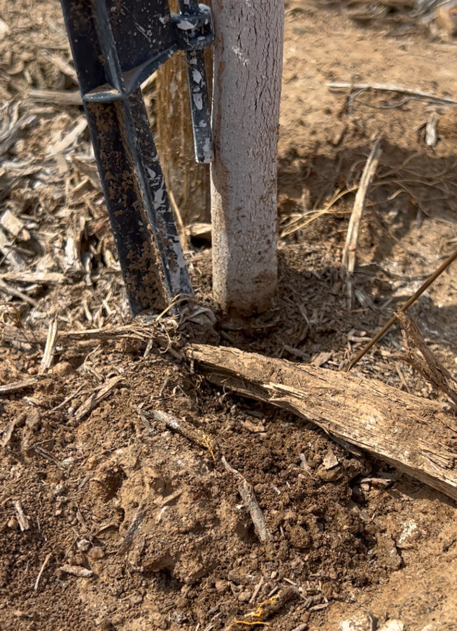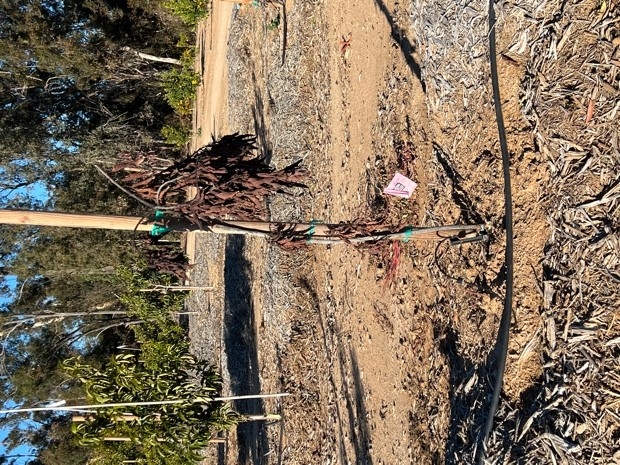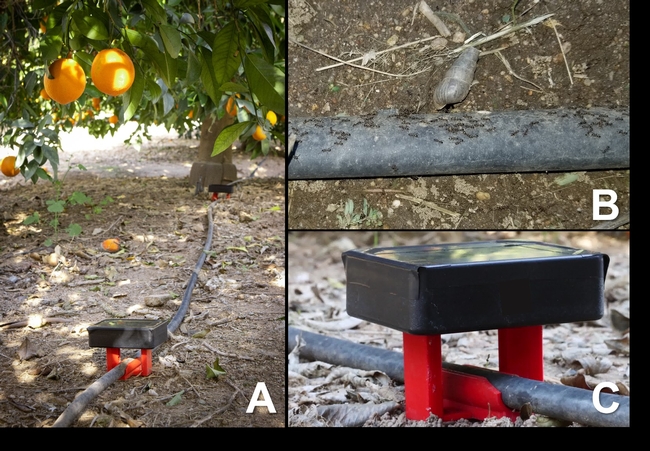
Posts Tagged: ant
New Avocado Pest
Red imported fire ant (RIFA), Solenopsis invicta, has been reported as a pest in Florida where the fire ants girdle young citrus trees (Diepenbrock) https://crec.ifas.ufl.edu/media/crecifasufledu/extension/extension-publications/2021/2021_jan_fireant.pdf Florida researchers found that RIFA girdled the trees and killed them. In the summer of 2022, we discovered newly planted avocado trees being girdled and killed in Riverside. Upon closer examination we discovered the girdling was from the activities of a fire ant. Dr. Dong-Hwan Choe, Professor of Extension – Entomologist at UC Riverside, identified it as Solenopsis sp. Figure 1 show the initial damage to an otherwise healthy avocado tree which weeks later was completely girdled and dead. Fire ants were controlled using a bait. This took 2 applications. Fire ant mound is evident in Figure 1B but is not the typical mound that is associated with fire ants so growers need to be watching for ant activity and treat proactively. The fire ants were very aggressive to both the tree and the people working the trees.

fire ant holes

fire ant girdle
Fire Ants Come to CA Avocado
Red imported fire ant (RIFA), Solenopsis invicta, has been reported as a pest in Florida where the fire ants girdle young citrus trees (Diepenbrock) https://crec.ifas.ufl.edu/media/crecifasufledu/extension/extension-publications/2021/2021_jan_fireant.pdf Florida researchers found that RIFA girdled the trees and killed them. In the summer of 2022, we discovered newly planted avocado trees being girdled and killed in WHERE?. Upon closer examination we discovered the girdling was from the activities of a fire ant. Dr. Dong-Hwan Choe, Professor of Extension – Entomologist at UC Riverside, identified it as Solenopsis sp. Figure 1 show the initial damage to an otherwise healthy avocado tree which weeks later was completely girdled and dead. Fire ants were controlled using a bait. This took 2 applications. Fire ant mound is evident in Figure 1B but is not the typical mound that is associated with fire ants so growers need to be watching for ant activity and treat proactively. The fire ants were very aggressive to both the tree and the people working the trees.
Figure 1: (A) initial holes made by fire ants. (B) girdled tree and mounds at basin of tree and (C) dead trees.
Synergizing Argentine Ant Control
Synergizing IPM of Argentine ant and biocontrol of sap sucking pests with biodegradable hydrogels, infra-red sensors, and cover crops in commercial citrus orchards
Ivan Milosavljevi?, Department of Entomology, University of California, Riverside, CA
Nicola A. Irvin, Department of Entomology, University of California, Riverside, CA
Kelsey A. McCalla, Department of Environmental Science, Policy, and Management University of California, Berkeley, CA
Mark S. Hoddle, Department of Entomology, University of California, Riverside, CA
Argentine Ant control critical for IPM in citrus groves
The invasive Argentine ant (AA) (Linepithema humile) is a serious impediment to the biological control of sap sucking pests (SSPs) in citrus orchards (Hoddle et al. 2022). SSPs include mealybugs, scales, aphids, and Asian citrus psyllid (ACP), the vector of a bacterium that causes HLB, a lethal citrus. AA protect >85% of SSPs and >55% of ACP colonies from their natural enemies which exacerbates pest infestations. In return for protection from natural enemies, ants are rewarded for this service by SSP's through the provision of a sugary waste product, honeydew, which ants harvest and return to nests to feed brood and queens. Contact sprays for AA and SSP control applied to soil, trunks, and foliage kill natural enemies, cause secondary pest outbreaks, and increase the likelihood of insecticide resistance developing. IPM of AA and SSPs requires an accurate method of assessing pest densities so that appropriate treatment decisions can be made, precision delivery of insecticides to kill foraging AA is necessary if natural enemies are to be preserved, and enhancement of natural enemies through conservation biocontrol can increase the efficacy of free pest control services provided by natural enemies in citrus orchards.
Enhancing and automating Argentine ant monitoring using infra-red sensors and the internet of things
Efficient and accurate pest monitoring is a key component of IPM programs. There are currently no standardized monitoring programs for assessing AA infestation levels. Visual ant counts are time consuming, tedious, and become inaccurate when counting fatigue sets in. To remedy this problem, we developed and field-tested infrared sensors (IRS) that clamp to irrigation lines to automate ant counts . AA use irrigation lines as super-highways to rapidly move across the orchard floor to reach pest infested citrus trees. Statistical analyses indicated that it is possible to predict with about 85% accuracy the average number of ants ascending tree trunks based on the average number of ants running on irrigation lines. Thus, ant counts made by IRS on lines can be used to accurately predict the average number of ants ascending tree trunks in citrus orchards. Ant counts made by IRS are relayed wirelessly to the cloud where average AA densities are reviewed on an App that is loaded onto a smart device. IRS's eliminate the need for humans to monitor ant densities, they provide block specific estimates of AA activity, and they can potentially operate 24/7/365! We are currently determining the minimum number of IRS needed per acre to estimate ant densities with fixed levels of precision (e.g., 85, 90, 95% accuracy).
Based on accurate ant density estimates treatment decisions can be made, and importantly, just the areas of the orchard exceeding acceptable ant densities can be identified and treated (Schall et al. 2018). Focused applications reduces insecticide use, saves money, and minimizes adverse effects of insecticide use on beneficial non-target species, like natural enemies (McCalla et al. 2020). As part of an AA IPM programs, treatment decisions require action thresholds and when AA densities exceed the action threshold, treatments can be initiated. At this time, there are currently no established action thresholds for AA in citrus. This is an important problem we are currently working on.
(A) Infra-red sensor (IRS) clamped onto an irrigation line in a commercial citrus orchard. (B) Argentine ants use polyethylene irrigation lines that sit on the soils surface as “super-highways” to move from underground nests to tree canopies where they collect honeydew. (C) Close-up of IRS counting Argentine ants running on irrigation lines. (Photos by Mike Lewis and Mark Hoddle, UC Riverside).
Hydrogel baits provided targeted and highly effective Argentine ant control in citrus orchards
Chlorpyrifos, the industry standard insecticide for AA control, was recently banned in California because it poses significant risks to human health. In response to this ban, we developed biodegradable hydrogel beads (HGBs) as an alternative highly specific treatment that targets AA. HGBs contain a 25% sucrose solution, and an ultra-low dose of insecticide (0.0001%). HGB's are applied to the ground under citrus trees and spread out so foraging AA can rapidly find them. Ants imbibe sugar water laced with insecticide, return it to the nest to feed brood and queens which kills them. Consequently, HGB's may provide a superior alternative to plastic liquid bait stations for delivering toxins to AA as bait stations are cost-prohibitive for mass use in orchards. Our lab has demonstrated that both thiamethoxam and an organically approved spinosad formulation are highly efficacious when delivered to AA using HGBs infused with sugar water that is laced with insecticide. Within 2-3 days of HGB applications, AA colonies collapse, and AA densities are reduced by >95% in comparison to untreated plots. Rapid (< 5 days) long term (> 3 months) control of AA results from repeated HGB applications (~3-4 applications ~3 weeks apart over summer). Once AA are controlled long-term reductions in densities of SSPs in citrus results because natural enemies are able to more effectively control SSP's in the absence of AA. We are currently determining the minimum amounts of HGBs, and frequency of applications needed to optimize AA control at the lowest costs to growers.
Using flowering plants to enhance natural enemies of ACP and SSPs in citrus orchards
Our previous work has shown that natural enemies, especially hover flies (syrphids), respond strongly to flowering alyssum (Lobularia maritima) and buckwheat (Fagopyrum esculentum). Field work has also shown that ACP in citrus plots with flowering plants suffer significantly greater levels of natural enemy attack, especially by predatory hover fly larvae, when compared to plots lacking flowering plants. Hover fly larvae are dominant predators attacking ACP nymphs and other SSPs in citrus (Kistner et al. 2016, 2017). Tamarixia radiata, a tiny parasitic wasp has been imported into California from the Punjab of Pakistan to attack ACP nymphs also feed from buckwheat flowers. We have also found that hoverflies in southern California are most active in spring and fall and this is when flowering plants are most beneficial to them. This finding is important as ACP (and SSP) populations are greatest in spring and over fall also. Sowing flowering plants late-February and re-sowing in early-September would synchronize hoverfly activity with ACP population increases. We are currently assessing the efficacy of flowering plants in multiple commercial citrus orchards to the magnitude of reductions in populations of ACP and SSP densities when cover crops are present and absent.
Take home messages
IPM of AA and SSP's in citrus, include ACP, requires new and innovative approaches if long-term sustainable management is to be achieved. To achieve this, we are working on developing a package that combines three tools, HGBs, IRS, and flowering plants that enhance monitoring of AA (IRS), provides targeted highly specific control of AA (HGBs) that in turn relieves natural enemies from pressure of foraging ants which permits them to increase the free pest management service that they provide in citrus orchards. These agroecosystem services provided by natural enemies can be further enhanced through resource provision, cover crops, which provide pollen and nectar to natural enemies. This combination of tools, IRS, HGBs and cover crops, synergizes IPM of AA and biocontrol of sap sucking pests infesting California-grown citrus.
Here Comes the Ant Man
Argentine Ant Management in Citrus (July 8, 2020)
What Are the UC Ag Experts Talking About?
What is involved in the webinars?
A series of 1-hour webinars, designed for growers and pest management professionals, highlighting various pest management and horticultural topics for citrus, avocados, and other subtropical crops. Master Gardeners can benefit from participating, but the pest management methods presented, especially the pesticides, are not to be followed without a clear understanding of their legal use by homeowners.
During each session, a UC Expert on the subject makes a presentation and entertains write-in questions via chat during and/or after the presentation. As we develop this program, we may expand to other crops. Both DPR CE units are available, as are CDFA-CCA units

mark hoddle and team
Control Argentine Ant and Biocontrol Can Really Work
Argentine Ant is a very aggressive invader that disrupts native ant populations and at the same time disrupts biocontrol agents that help control, such pests as scale, aphids and mealy bugs in citrus and other tree crop species. They defend these sugar producing sources of energy from attack by predators and parasites, like parasitic wasps and predatory assassin bugs and lady bugs. They increase the threat of Asian Citrus Psyllid and HLB by protecting the psyllid from attack by parasitic Tamarixia.
A careful, well placed chlorpyrifos spray has been used to control Argentine ants. A trunk spray and/or spray on irrigation lines has disrupted their activity with minimal impact on beneficials. This protectant spray keeps the Argentine ants out of the canopies and allows the beneficials access to the pests. Controlling this one species, can have significant impact on biocontrol and the whole need for controlling pests.
Chlorpyrifos is a pesticide that might lose registration and other materials and techniques have been examined over the years as a replacement. A recent procedure has been proposed and used successfully on Santa Cruz Island to control introduced Argentine ants. The ant has caused tremendous disruption in biocontrol and it appears to have been controlled by this new technique. We are in the process of evaluating it's use in citrus. The application technique, costs and materials would need to be modified for use in citrus orchards. The current procedure would not be considered an organic practice since the pesticide material is not registered organic. It might be possible to use an organically registered material in the future.
Protocols for Argentine ant eradication in conservation areas
L.Boser1,C.Hanna2,D.A.Holway3,K.R.Faulkner4,I.Naughton3,K.Merrill5,J.M.Randall1,C.Cory1,D.-H. Choe6 & S. A.Morrison
Journal of Applied Entomology
http://onlinelibrary.wiley.com/doi/10.1111/jen.12372/full
The Argentine ant (Linepithema humile) is a widespread, abundant and ecologically disruptive invader that is present throughout major portions of coastal California and on half of the California Channel Islands. On Santa Cruz Island, the Argentine ant had invaded about 2% of the island's area in four distinct locations as of 2012. Given the negative ecological effects resulting from Argentine ant invasions,we sought to develop a cost-effective method of eradication. Here, we describe the results of large-scale, field-tested methods for Argentine ant eradication and post-treatment detection. Our eradication protocol employs a novel toxicant-delivery system: an aqueous solution of sucrose and 6 ppm of thiamethoxam mixed with hydrating polyacrylamide beads. Ants feed on the solution present on the bead's surface for about 24h after which time bead dehydration prevents feeding. We distributed hydrated beads by helicopter over 74 ha of infested areas plus a 50-m buffer on 14 occasions between June 2013 and September 2014. Treatments reduced Argentine ant activity to subdetectable levels within four months. In 2014, we conducted a high-intensity detection protocol using lures (n = 55 363) in areas treated in 2013.This effort did not detect Argentine ants. In 2015, we conducted a medium-intensity detection protocol using lures (n=2250) in areas treated in 2013 and 2014 but not searched in 2014; this sampling effort did not detect Argentine ant activity except for a single remnant infestation (c.0.3ha in area),which was retreated in2015.Thec ost of treatments was approximately $1400 per ha; this cost is comparable to other ant eradication efforts. The cost of our preferred detection method, which used lures spaced every 10m,was $500 per ha.These results demonstrate sufficient protocol efficacy to justify expansion of treatments to other infested areas in ecologically sensitive areas.
Photo: Argentine ant and scale
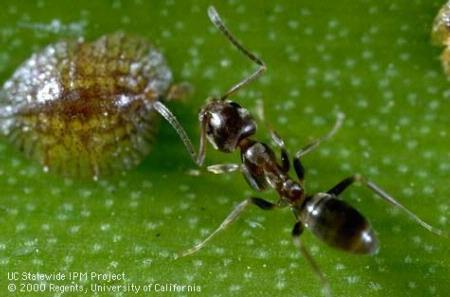
argentine ant and scale

